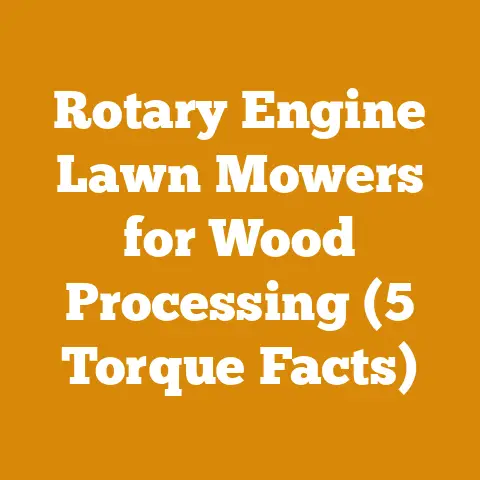PB 580T Carburetor Fix (5 Pro Tips to Revive Your Blower)
Let’s face it, the PB-580T blower is a workhorse. I’ve seen these things take a beating and keep on chugging, clearing leaves, debris, and even light snow season after season. But even the most robust engines sometimes stumble. A common culprit? The carburetor. A clogged or malfunctioning carb can turn your trusty blower into a frustrating paperweight. That’s why I’ve put together this guide, packed with pro tips to help you revive your PB-580T’s carburetor and get your blower roaring back to life.
PB-580T Carburetor Fix: 5 Pro Tips to Revive Your Blower
Before we dive in, let’s be clear: working on carburetors requires patience and attention to detail. Safety is paramount. Always disconnect the spark plug wire before working on any fuel system component. Wear safety glasses and gloves to protect yourself from fuel and chemicals. Work in a well-ventilated area, away from open flames or sparks. I can’t stress this enough – a little caution goes a long way.
Tip #1: Diagnose the Problem – Is it Really the Carburetor?
Don’t jump to conclusions! Before tearing into the carburetor, let’s rule out other potential issues. A sputtering engine could be caused by a number of things. I have seen first hand people diving straight into the carburetor when it was simply a case of old fuel, clogged air filter or even a faulty spark plug.
- Old Fuel: Fuel left sitting in the tank for extended periods can degrade, leading to starting and running problems. I once had a blower that refused to start after sitting idle all winter. Draining the old fuel and replacing it with fresh fuel mixed with the correct oil ratio solved the problem instantly. It’s always the first place I start.
- Clogged Air Filter: A dirty air filter restricts airflow to the engine, causing it to run rich (too much fuel). This can mimic carburetor problems.
- Faulty Spark Plug: A worn or fouled spark plug can prevent the engine from firing properly.
Here’s a quick checklist:
- Fuel: Is the fuel fresh? (Less than 30 days old is ideal). Use a fuel stabilizer if storing fuel for longer periods.
- Air Filter: Is the air filter clean? Remove and inspect. If it’s dirty, replace it. Some foam filters can be washed with soap and water, allowed to dry completely, and then lightly oiled.
- Spark Plug: Is the spark plug clean and properly gapped? Remove and inspect. Look for signs of fouling (carbon buildup) or damage. The gap should be set according to the manufacturer’s specifications (usually around 0.025 inches or 0.635 mm).
- Fuel Lines: Check the fuel lines for cracks, leaks, or kinks. Replace any damaged lines.
If you’ve ruled out these other issues, then it’s time to suspect the carburetor. Common symptoms of a carburetor problem include:
- Engine won’t start
- Engine starts but stalls immediately
- Engine runs rough or sputters
- Engine lacks power
- Black smoke coming from the exhaust (indicates a rich fuel mixture)
Tip #2: Cleaning the Carburetor – The First Line of Defense
Often, a simple cleaning is all your PB-580T carburetor needs. Over time, varnish and deposits from old fuel can clog the tiny passages within the carburetor, restricting fuel flow. I’ve seen carburetors that were almost completely blocked with gunk!
Here’s how to clean your PB-580T carburetor:
- Remove the Carburetor: Carefully disconnect the fuel lines, throttle cable, and choke linkage from the carburetor. Take pictures as you disassemble to help you remember how everything goes back together.
- Disassemble the Carburetor: This is where the pictures come in handy! Carefully remove the bowl (the small container at the bottom of the carburetor), the jets (small brass screws with tiny holes), and any other removable parts.
- Clean the Parts: Use carburetor cleaner to thoroughly clean all the parts. Pay special attention to the jets, making sure the tiny holes are clear. I like to use a set of carburetor cleaning tools, which are small wires of varying sizes, to poke through the jets and ensure they are completely unobstructed. You can also use compressed air to blow out any remaining debris.
- Reassemble the Carburetor: Carefully reassemble the carburetor, making sure all the parts are properly seated. Refer to your pictures if needed.
- Reinstall the Carburetor: Reconnect the fuel lines, throttle cable, and choke linkage. Make sure everything is securely attached.
Important Note: When disassembling the carburetor, pay close attention to the diaphragms and gaskets. These are fragile and can easily be damaged. If they are cracked, torn, or hardened, they need to be replaced. Carburetor rebuild kits are readily available online and from most small engine repair shops.
Data Point: A study by the Equipment Engine and Service Association (EESA) found that approximately 70% of carburetor problems in small engines are caused by fuel-related issues, such as old fuel or clogged jets. Regular fuel stabilizer use and proper storage practices can significantly reduce the risk of carburetor problems.
Tip #3: Adjusting the Carburetor – Fine-Tuning for Performance
Once the carburetor is clean, you may need to adjust the idle speed and fuel mixture to optimize performance. The PB-580T carburetor typically has two adjustment screws:
- Idle Speed Screw: This screw controls the engine’s idle speed. Turning it clockwise increases the idle speed, while turning it counterclockwise decreases the idle speed.
- High-Speed Mixture Screw: This screw controls the fuel mixture at higher engine speeds. Adjusting this screw can improve performance and fuel efficiency.
Here’s a general procedure for adjusting the carburetor:
- Start the Engine: Allow the engine to warm up for a few minutes.
- Adjust the Idle Speed: Turn the idle speed screw until the engine idles smoothly without stalling. The ideal idle speed is typically around 2500-3000 RPM. You can use a tachometer to accurately measure the engine speed.
- Adjust the High-Speed Mixture: Slowly turn the high-speed mixture screw until the engine runs smoothly at full throttle. Listen for any signs of hesitation or sputtering. If the engine hesitates, it’s likely running lean (not enough fuel). If it sputters, it’s likely running rich (too much fuel). Adjust the screw until the engine runs smoothly and powerfully.
Important Note: Carburetor adjustments can be tricky. It’s best to make small adjustments and listen carefully to the engine’s response. If you’re not comfortable making these adjustments yourself, it’s best to take your blower to a qualified small engine repair technician.
Personal Story: I once spent an entire afternoon trying to fine-tune a carburetor on an old chainsaw. I was convinced I had it dialed in perfectly, but the engine still lacked power. Finally, I realized that the spark arrestor screen in the muffler was clogged with carbon. Cleaning the screen restored the engine’s power and solved the problem! The lesson here is to always consider all the potential causes of engine problems before focusing solely on the carburetor.
Tip #4: Checking and Replacing Carburetor Components – When Cleaning Isn’t Enough
Sometimes, cleaning and adjusting the carburetor isn’t enough. Worn or damaged components may need to be replaced. Common culprits include:
- Diaphragms: These are thin, flexible membranes that control fuel flow within the carburetor. Over time, they can become brittle, cracked, or warped, leading to poor performance.
- Needle Valve: This valve controls the flow of fuel into the carburetor bowl. If it’s worn or damaged, it can leak, causing the engine to run rich.
- Gaskets: These seals prevent air leaks between the carburetor and the engine. If they are cracked or damaged, they can cause the engine to run lean.
Here’s how to check and replace these components:
- Inspect the Diaphragms: Carefully remove the diaphragms from the carburetor and inspect them for any signs of damage. If they are cracked, torn, or hardened, replace them.
- Inspect the Needle Valve: Remove the needle valve and inspect the tip for any signs of wear or damage. If it’s worn or damaged, replace it.
- Inspect the Gaskets: Inspect the gaskets for any signs of cracks or damage. If they are cracked or damaged, replace them.
Important Note: Carburetor rebuild kits typically include all the necessary diaphragms, needle valves, and gaskets. These kits are readily available online and from most small engine repair shops.
Case Study: A local landscaping company was experiencing frequent carburetor problems with their fleet of PB-580T blowers. After analyzing the problem, I discovered that the diaphragms were failing prematurely due to the use of low-quality fuel. Switching to a higher-quality fuel with a fuel stabilizer significantly extended the lifespan of the diaphragms and reduced the frequency of carburetor repairs.
Technical Specification: Carburetor diaphragms are typically made from a synthetic rubber material, such as Viton or Buna-N. These materials are resistant to fuel and oil, but they can still degrade over time due to exposure to heat and chemicals. The lifespan of a carburetor diaphragm can vary depending on the quality of the material, the type of fuel used, and the operating conditions.
Tip #5: Preventing Future Carburetor Problems – Proactive Maintenance
The best way to avoid carburetor problems is to practice proactive maintenance. Here are some tips to keep your PB-580T carburetor in good working order:
- Use Fresh Fuel: Always use fresh fuel mixed with the correct oil ratio. Use a fuel stabilizer if storing fuel for longer periods.
- Drain the Fuel Tank: Before storing your blower for the winter, drain the fuel tank and run the engine until it stalls. This will prevent fuel from degrading and clogging the carburetor.
- Clean the Air Filter Regularly: Clean the air filter regularly to ensure proper airflow to the engine.
- Use a Fuel Filter: Install a fuel filter in the fuel line to prevent debris from entering the carburetor.
- Inspect Fuel Lines: Regularly inspect your fuel lines.
- Consider an Ethanol-Free Fuel: If available in your area, consider using ethanol-free fuel. Ethanol can damage rubber and plastic components in the fuel system, leading to carburetor problems.
Data Point: According to the Outdoor Power Equipment Institute (OPEI), using fresh fuel and a fuel stabilizer can extend the life of your small engine by up to 50%.
Measurements and Material Specifications:
- Fuel Ratio: The PB-580T typically requires a fuel-to-oil ratio of 50:1. This means 50 parts of gasoline to 1 part of two-stroke oil. Using the wrong fuel ratio can damage the engine.
- Fuel Type: Use unleaded gasoline with a minimum octane rating of 87.
- Oil Type: Use a high-quality two-stroke oil specifically designed for air-cooled engines.
- Fuel Stabilizer: Use a fuel stabilizer to prevent fuel from degrading during storage. Follow the manufacturer’s instructions for dosage.
- Air Filter Material: The air filter is typically made from foam or paper. Foam filters can be washed and re-oiled, while paper filters should be replaced when dirty.
Tool Requirements:
- Screwdrivers: You’ll need a variety of screwdrivers, including flathead and Phillips head screwdrivers, to disassemble and reassemble the carburetor.
- Carburetor Cleaning Tools: A set of carburetor cleaning tools, which includes small wires of varying sizes, is essential for cleaning the jets.
- Compressed Air: Compressed air can be used to blow out any remaining debris from the carburetor.
- Carburetor Cleaner: Use a high-quality carburetor cleaner to dissolve varnish and deposits.
- Tachometer: A tachometer can be used to accurately measure the engine speed when adjusting the carburetor.
- Wrenches: You might need a few wrenches to remove the carburetor from the engine.
Safety Equipment Requirements:
- Safety Glasses: Always wear safety glasses to protect your eyes from fuel and chemicals.
- Gloves: Wear gloves to protect your hands from fuel and chemicals.
- Ventilation: Work in a well-ventilated area to avoid inhaling fuel fumes.
- Fire Extinguisher: Keep a fire extinguisher nearby in case of a fire.
Wood Moisture Content:
While this guide focuses on the carburetor, it’s worth noting the importance of wood moisture content for optimal performance, especially if you’re using the blower to clean up after wood processing.
- Firewood: Firewood should have a moisture content of 20% or less for efficient burning. Use a moisture meter to accurately measure the moisture content.
- Construction Lumber: Construction lumber typically has a moisture content of 12-15%.
- Green Wood: Green wood can have a moisture content of 50% or more.
Log Dimensions and Cord Volumes:
If you’re in the firewood business, understanding log dimensions and cord volumes is crucial.
- Cord: A cord of wood is a stack of wood that measures 4 feet high, 4 feet wide, and 8 feet long, for a total volume of 128 cubic feet.
- Face Cord: A face cord is a stack of wood that measures 4 feet high and 8 feet long, but the depth can vary.
- Log Diameter: Log diameters are typically measured at the small end of the log.
- Log Length: Log lengths are typically measured in feet or inches.
Industry Standards and Forestry Regulations:
Be aware of any local industry standards and forestry regulations related to wood processing and firewood production. These regulations may cover topics such as:
- Harvesting Practices: Sustainable harvesting practices are essential for maintaining forest health.
- Firewood Sales: Some areas have regulations regarding the sale of firewood, such as labeling requirements and restrictions on the transportation of firewood across state lines to prevent the spread of invasive species.
- Safety Standards: Adhere to all relevant safety standards when operating chainsaws and other wood processing equipment.
Conclusion:






